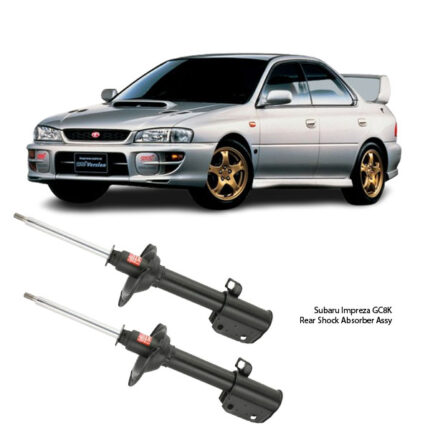Get KYB Shock Absorber Subaru Legacy Rear 334116
A shock absorber is a mechanical or hydraulic device designed to absorb and dampen shock impulses in a vehicle’s suspension system. Its primary function is to control the movement of the vehicle’s suspension, ensuring a smoother ride and better handling by managing the impact of road irregularities.
Benefits;
1. Improved Ride Comfort
- Smoother Ride: Shock absorbers dampen the impact of bumps, potholes, and other road irregularities, providing a smoother ride for passengers.
- Reduced Vibrations: They minimize the vibrations transmitted through the vehicle, contributing to a quieter and more comfortable driving experience.
2. Enhanced Vehicle Handling and Stability
- Better Control: Shock absorbers help maintain tire contact with the road, ensuring better control and stability during various driving conditions, such as cornering, accelerating, and braking.
- Reduced Body Roll: They minimize body roll during turns, enhancing the vehicle’s stability and handling characteristics.
- Improved Steering Response: Enhanced handling and stability provided by shock absorbers lead to more precise and responsive steering.
3. Increased Safety
- Shorter Stopping Distances: By keeping the tires in better contact with the road, shock absorbers contribute to more effective braking, potentially shortening stopping distances.
- Consistent Tire Contact: Ensuring consistent tire contact with the road surface reduces the risk of losing control, especially in emergency situations or on uneven terrain.
4. Prolonged Tire Life
- Even Tire Wear: By controlling the up-and-down movement of the wheels, shock absorbers help to distribute tire wear more evenly, prolonging the life of the tires and improving their performance.
- Reduced Suspension Wear: They protect other suspension components from excessive wear and tear by absorbing and dissipating energy from impacts.
5. Protection for Vehicle Components
- Minimized Stress: Shock absorbers reduce the stress on other vehicle components such as the chassis, axles, and drivetrain by damping the forces generated by road irregularities.
- Lower Maintenance Costs: By mitigating wear and tear on suspension components and tires, shock absorbers can help reduce overall maintenance and repair costs.
6. Optimized Vehicle Performance
- Consistent Performance: Shock absorbers ensure consistent vehicle performance under various driving conditions by maintaining optimal suspension behavior.
- Adaptability: Advanced shock absorbers, such as adjustable or electronically controlled ones, allow for adaptability to different driving environments and preferences, providing both comfort and performance when needed.
7. Reduced Driver Fatigue
- Comfortable Driving Experience: A smoother ride and better handling reduce driver fatigue, especially on long journeys, leading to safer driving conditions.
- Enhanced Concentration: Less vibration and jolting help drivers maintain focus and comfort, which is critical for safe driving.
Signs a Car needs new shock absorber;
1. Unusual Noises
- Clunking or Banging: Hearing clunking, banging, or rattling noises when driving over bumps or rough roads may indicate worn shock absorbers.
- Squeaking: Persistent squeaking sounds during normal driving can also suggest that the shocks are worn out and need replacement.
2. Poor Ride Quality
- Excessive Bouncing: If your vehicle continues to bounce after hitting a bump or pothole, it’s a sign that the shock absorbers are not dampening the motion effectively.
- Rough Ride: A noticeably rougher ride, where you feel every bump and irregularity in the road, can indicate that the shocks are no longer absorbing impacts properly.
3. Handling Issues
- Reduced Stability: Difficulty in maintaining control of the vehicle, especially during turns, acceleration, or braking, can be a result of faulty shock absorbers.
- Nose Diving: If the front of the car dips excessively when you apply the brakes, it indicates worn shocks.
- Rear Squatting: The rear end of the car squatting or dipping when you accelerate is another sign of shock absorber issues.
- Excessive Body Roll: Increased body roll or sway when turning or changing lanes can signal worn shock absorbers.
4. Visual Inspection
- Leaking Fluid: Shock absorbers contain hydraulic fluid. If you notice oily residue or leaks on the shock absorber or on the ground underneath your vehicle, it’s a clear sign they need to be replaced.
- Physical Damage: Inspect the shock absorbers for dents, cracks, or other signs of physical damage.
5. Uneven Tire Wear
- Cupping or Bald Spots: Uneven tire wear, such as cupping or bald spots, can be a sign that the shock absorbers are not keeping the tires firmly on the road, leading to inconsistent tire contact and wear patterns.
6. Increased Stopping Distance
- Longer Braking Distances: If you notice that your vehicle takes longer to stop than usual, it could be due to ineffective shock absorbers impacting braking efficiency.
7. Vehicle Swaying
- Swaying in Wind: Excessive swaying or leaning in crosswinds or on curves suggests that the shocks are not providing the necessary stability.
8. Warning Lights
- Suspension Warning Light: Some modern vehicles have suspension warning lights on the dashboard. If this light illuminates, it’s worth getting the shock absorbers checked.
9. Vehicle Mileage
- High Mileage: Shock absorbers typically last between 50,000 to 100,000 miles, depending on driving conditions and usage. If your vehicle is within this range or beyond, it might be time to have them inspected and potentially replaced.
Follow us on Facebook for more parts.


